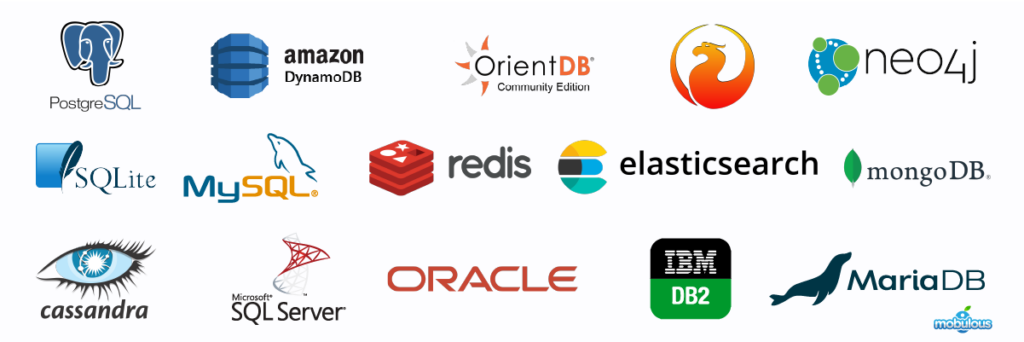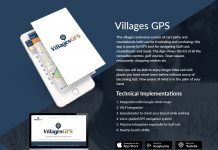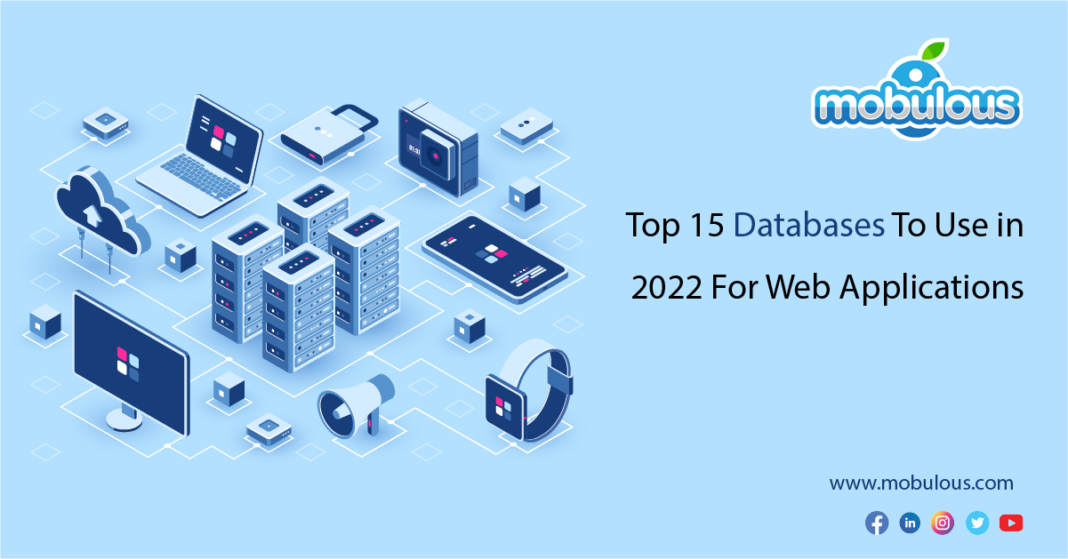Most Popular Databases: Whether a company is a little corporation or a giant conglomerate, digital transformation has made it possible for businesses to produce information at every touchpoint. Any business needs a database to manage and keep its essential data regardless of size.
A database can be considered an office where all the essential information and documents are kept. Because the information in the database is so sensitive, we must proceed with the utmost caution when accessing its contents.
Numerous NoSQL, NewSQL, and Cloud databases are currently being added to the old SQL list of well-known databases. Microservices, Cloud, Distributed Apps, Semi-Structured Data, and other technologies like Big Data and Low Latency Data have emerged.
So, here in this blog we will help you know the top 15 databases that you can use for your web apps.
Stats Related To The Database For Web Apps in 2023 Or Coming Years-
- The Global Enterprise Database Management System (DBMS) Market, expected to reach USD 31.154 billion in 2021, is anticipated to increase at a CAGR of 21.92 percent to reach USD 124.728 billion by 2028.
- Business.com claims that 91% of businesses with more than 11 employees utilize CRM software.
- According to Nucleus Research research, 65% of businesses adopting CRM for mobile web development meet their sales targets.
- Future Market Insights predicts that between 2019 and 2029, the mobile CRM market will expand at a roughly 13% CAGR.
The Top 15 Databases For Web Apps-
MySQL is the most popular database among people learning to code. At the same time, PostgreSQL is the preferred database among seasoned developers, according to the 2023 Stack Overflow Developer Survey, which garnered over 70,000 responses.

- MySQL
MySQL is considered one of the popular relational database management systems. The database is created and maintained by Oracle. 46.85% of the developers who participated in the 2023 Stack Overflow developer survey said they utilized it, making it one of the most well-liked databases. MySQL is indeed the best database choice for web applications.
MySQL is renowned for being incredibly dependable and mature and was created using C and C++. It comes with a lot of features and is updated frequently. Additionally, it provides cross-platform compatibility and a security layer for delicate data.
Many big companies, like Facebook, Twitter, Verizon, and others, favor MySQL as their database of choice. Additionally, it is the go-to database for developing unique online applications created using Joomla, Drupal, and WordPress.
- Oracle
Oracle is a well-liked database management system that provides scalability and fast performance to web apps.
It was created using RDBMS and assembly languages like Java, C, and C++. It analyses data faster and uses less space than conventional databases.
Oracle will remain the most well-liked database even in the coming years. According to experts closely following this field, the most recent release (21C) has introduced several novel features that make it an appealing choice for the future.
- PostgreSQL
Another database that we have included in our list is PostgreSQL. The database is used by 43.59 percent of poll participants.
It is a relational database management system built on SQL to create mobile and web applications. It was made in C, produced by developer community members, and is an open-source database.
PostgreSQL is simple to understand and modify. It can handle a wide range of requirements and has the characteristics of an enterprise class. It supports Java, Python, C#, C, C++, Ruby, and other languages.
Additionally, it supports JSON for non-relational queries and SQL for relational questions.
- MS SQL Server
If we believe the report of the survey, Microsoft SQL Server is purportedly used in the IT stacks of 1056 businesses, including Accenture, Hepsiburada, and Microsoft.
When high performance and extensive functionality are needed, the Microsoft SQL Server is a great option. It may be utilized in any corporate setting for various functions like business intelligence or analytics apps, giving you more insight into the success of your organization while requiring less time for laborious chores.
Microsoft offers twelve different editions of SQL Server to accommodate various user bases and workloads.
- MongoDB
The open-source MongoDB database is a document-oriented NoSQL database. It was published in 2009, and 28.3% of those who responded to the survey used it.
MongoDB makes it simple to handle document data without using any extra programs. Developers can use MongoDB to build various databases and document collections with multiple fields and data formats.
Regarding NoSQL systems, MongoDB is one of the top database choices for web applications. It is an attractive option for creating horizontally scaled, high-availability programs because it is simple to learn and use.
Moreover, It has Numerous programming languages and platforms.
- SQLite
SQLite is an open-source relational database management system. And, if we believe the report, 32.01 percent of respondents use SQLite.
The language used is C. Instead of being a separate database, SQLite is a library that can be incorporated into apps and includes many smartphones and laptops. SQLite’s fundamental API is compact and straightforward, even for beginners.
Moreover, it has no external requirements and can support terabyte-sized databases.
- Redis
Redis is an in-memory data store that is free to use and may be used as a database and a caching system.
It offers a variety of formats, including strings, lists, hashes, sorted sets with range searches, bitmaps, hyper logs, streams, geospatial indexes, and sets.
- ElasticSearch
With its automatic sharing capability and API, Elasticsearch is a full-text search engine that can readily support horizontal scalability.
Whether it is logging or monitoring statistics, it has the capacity and the desire for all forms of data.
- IBM DB2
The state-of-the-art stage from IBM is AI-controlled and built to deliver information wherever required.
Its well-proven task-prepared qualities give you a complete picture while cutting costs thanks to its multimodal skills, which do away with the need for simultaneous imitations or relocations.
Access to every area of a firm or business is made possible by a flexible basis powered by contemporary advances without being slowed down by numerous systems.
- Cassandra
Cassandra can easily handle enormous volumes of data thanks to its open-source nature and robust column store features.
Due to its ability to endure failures, it has gained popularity among businesses in various industries. This makes it appropriate when dealing with flaws or even a massive volume of traffic on your website.
- MariaDB
The MySQL standard is compatible with MariaDB, an RDMS.
Without changing the code, it is typically used to change your MySQL server.
Compared to MySQL, it is more concerned with the local area network.
With its columnar capacity and widely distributed parallel data, this structure makes working with large data sets faster and easier.
- OrientDB
OrientDB is a graphical database framework that can utilize NoSQL’s potential without creating multiple frameworks to manage various data.
Supporting a range of models also enhances performance, scalability, and security.
- DynamoDB
A non-relational database from Amazon is called DynamoDB.
It’s a serverless database for mobile apps that automatically scales up and down and backs up your data.
This database application has constant latency, in-memory caching, and built-in security.
- Neo4j
Launched in 2007, Neo4j is a free, Java-based NoSQL graph database. It employs the Cypher query language, marketed as the most effective and expressive way to express relationship questions on its website.
Your data is saved in this database management system software as graphs rather than tables.
Neo4j’s relationship architecture is rapid and lets you build more relationships as needed to “shortcut” and accelerate domain data.
- Firebird SQL
For various Unix platforms, Mac OS X, Windows, and Linux, Firebird is a free SQL RDBMS.
This core database has enhanced the multi-stage RDBMS. It offers various financial choices, from firebird enrollments to sponsorship commitments.
Final Words-
A few years ago, choosing a database was a considerably easier procedure. For the majority of the criteria, selecting a relational database was all that was necessary.
As software development has progressed, the selection procedure has become more essential. This article covered the top databases on the market in great detail.
The majority of firms nowadays use many databases to operate.
Therefore, integrating data from these databases might be challenging if a common analysis is needed. First, a data integration solution must be created to combine and centrally store the data from these databases. Companies can use pre-existing platforms or develop their data integration solutions.
Mobulous is a top web & mobile app development company that will integrate the best database into your web apps.
Visit Mobulous for Mobile App Development Services
Mail

































